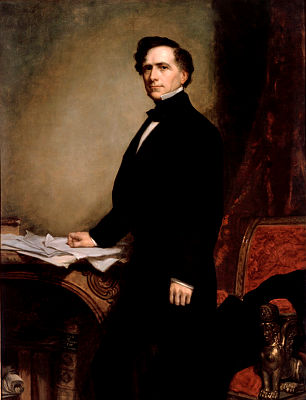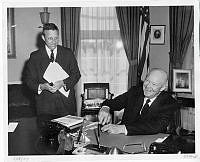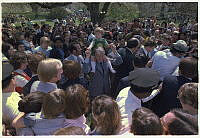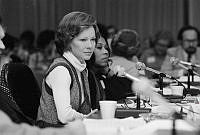Franklin Pierce

Franklin Pierce became president at a time of what seemed on the surface like domestic tranquility. The United States, by virtue of the Compromise of 1850, seemed to have weathered its sectional storm. By following the recommendations of southern advisers, Pierce—a New Englander— hoped to prevent another outbreak of that storm. But his policies, far from preserving calm, hastened the disruption of the Union.
Born on November 23, 1804 in in Hillsborough, New Hampshire, Pierce attended Bowdoin College. After graduation he studied law, then entered politics. In 1829, he was elected to the New Hampshire legislature; two years later he became its speaker. During the 1830s and 1840s he went to Washington, first as a representative, then as a senator. In 1834, Pierce married Jane Means Appleton, and they had three sons.
Pierce, after serving in the Mexican-American War, was proposed by New Hampshire friends for the presidential nomination in 1852. At the Democratic Convention, the delegates agreed easily enough upon a platform pledging undeviating support of the Compromise of 1850 and hostility toward any efforts by the federal government to interfere with slavery. On the 49th ballot, they nominated Pierce, a true dark horse candidate.
Although Pierce only won the popular vote by about 200,000 votes, he received 254 electoral votes to Whig candidate General Winfield Scott’s 42. He appealed to southern and northern Democrats, New Englanders, and even southern Whigs. Two months before he took office, his 11-year-old son Benjamin was killed in a horrific train accident—Ben was the third and final son to die young. Grief stricken and childless, Pierce and his wife Jane struggled to cope with these losses throughout his presidency and for the rest of their lives.
In his Inaugural Address he proclaimed an era of peace and prosperity at home, and vigor in relations with other nations. The United States might have to acquire additional possessions for the sake of its own security, he pointed out, and would not be deterred by “any timid forebodings of evil.”
Pierce had only to make gestures toward expansion to excite the wrath of northerners, who accused him of collaborating with southerners to extend slavery into other areas. Therefore he aroused apprehension when he pressured Great Britain to relinquish its special interests along part of the Central American coast, and even more when he tried to persuade Spain to sell Cuba.
But the most violent renewal of national turbulence came from the Kansas-Nebraska Act, which repealed the Missouri Compromise of 1820 and reopened the question of slavery in the West. This measure, the handiwork of Senator Stephen A. Douglas, grew in part out of Douglas’s desire to promote a railroad from Chicago to California through Nebraska. Secretary of War Jefferson Davis, advocate of a southern transcontinental route, had already persuaded Pierce to send James Gadsden to Mexico to buy land for a southern railroad. He purchased the area now comprising southern Arizona and part of southern New Mexico for $10,000,000.
Douglas’s proposal, to organize western territories through which a railroad might run, caused extreme trouble. Douglas provided in his bills that the residents of the new territories could decide the slavery question for themselves—otherwise known as popular sovereignty. The result was a rush into Kansas, as proslavery and antislavery activists vied for control of the territory. Violence ensued, and “Bleeding Kansas” became a prelude to the Civil War.
Pierce sought a second term in office but Democrats decided to nominate the less controversial James Buchanan. He returned to New Hampshire, leaving his successor to face the growing sectional crisis. During the Civil War, Pierce continued to support the Democratic Party and blamed President Abraham Lincoln for the war. A lifelong drinker, Pierce became a recluse during his final years, dying of cirrhosis on October 8, 1869.





































